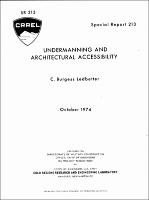Please use this identifier to cite or link to this item:
https://hdl.handle.net/11681/11727Full metadata record
| DC Field | Value | Language |
|---|---|---|
| dc.contributor.author | Ledbetter, C. Burgess | - |
| dc.date.accessioned | 2016-06-20T14:22:24Z | - |
| dc.date.available | 2016-06-20T14:22:24Z | - |
| dc.date.issued | 1974-10 | - |
| dc.identifier.uri | http://hdl.handle.net/11681/11727 | - |
| dc.description | Special Report | - |
| dc.description | Abstract: Preliminary results from behavior setting surveys conducted at remote military stations in Alaska for deriving habitability criteria for cold regions military installations reveal the architectural factor of accessibility to significantly influence undermanning. Undermanning is the organizational situation in which there are fewer people available to perform any job and hence each person is under pressure to participate. Centralized informal gathering areas, called focal points, were found to be determined by architectural design and appear to influence the degree of undermanning, permitting a reduction in the formal work load. | - |
| dc.publisher | Cold Regions Research and Engineering Laboratory (U.S.) | - |
| dc.publisher | Engineer Research and Development Center (U.S.) | - |
| dc.relation | http://acwc.sdp.sirsi.net/client/en_US/search/asset/1012586 | - |
| dc.rights | Approved for public release; distribution is unlimited. | - |
| dc.source | This Digital Resource was created from scans of the Print Resource | - |
| dc.subject | Architecture | - |
| dc.subject | Arctic regions | - |
| dc.subject | Construction | - |
| dc.subject | Habitability | - |
| dc.subject | Psychological effects | - |
| dc.subject | Military bases | - |
| dc.subject | Manpower planning | - |
| dc.title | Undermanning and architectural accessibility | - |
| dc.type | Report | en_US |
| Appears in Collections: | Special Report | |
Files in This Item:
| File | Description | Size | Format | |
|---|---|---|---|---|
| SR-213.pdf | 610.78 kB | Adobe PDF |  View/Open |